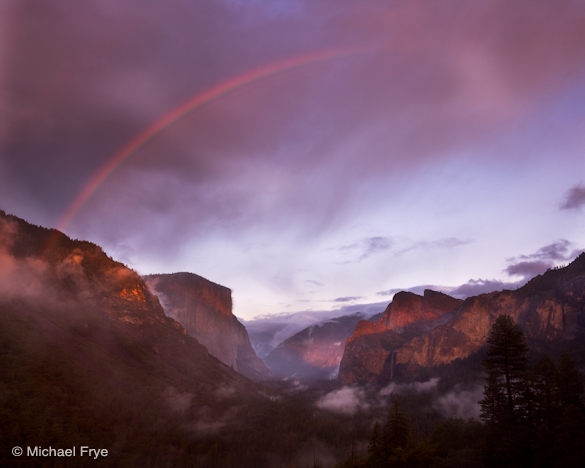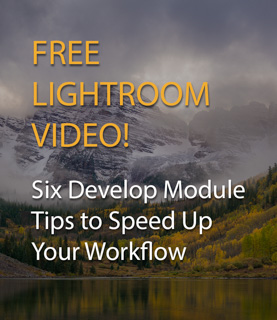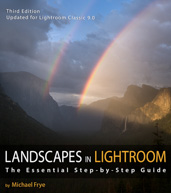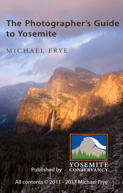by Michael Frye | Sep 17, 2009 | Workshops

I’ve posted more student images from June’s Hidden Yosemite Valley workshop and July’s Full Moon Night Photography workshop. I’m constantly amazed by the level of talent people bring to these classes, as in John Robert’s photograph above of a misty sunrise from Swinging Bridge. Click here to go to my workshop page, then scroll down to see a list of workshop slide shows.
by Michael Frye | Sep 12, 2009 | Yosemite Photo Conditions

Rainbow over Yosemite Valley from Tunnel View, October 4th, 2008
As the days get shorter and cooler, the photo opportunities in the Yosemite area get hotter. It’s time to take a look at what to expect during the next few months.
September
 You won’t find much autumn color in Yosemite before October, but the indian rhubarb in Bridalveil and Leidig Meadows can add an early splash of yellow, as in this photo from the west end of Leidig. Near the fall equinox on September 22nd, and for a couple of weeks afterward, the sun sets at a good angle for Tunnel View, lighting both El Capitan on the left and Cathedral Rocks on the right. The two or three weeks before the spring equinox are even better, as there’s usually water in Bridalveil Fall, but fall can be great in the right weather conditions, like last year when I saw the rainbow at the top of this post.
You won’t find much autumn color in Yosemite before October, but the indian rhubarb in Bridalveil and Leidig Meadows can add an early splash of yellow, as in this photo from the west end of Leidig. Near the fall equinox on September 22nd, and for a couple of weeks afterward, the sun sets at a good angle for Tunnel View, lighting both El Capitan on the left and Cathedral Rocks on the right. The two or three weeks before the spring equinox are even better, as there’s usually water in Bridalveil Fall, but fall can be great in the right weather conditions, like last year when I saw the rainbow at the top of this post.
On the east side of the Sierra Nevada the high-elevation aspens usually start turning yellow in late September. The Bishop Creek area, west of Bishop, and Convict Lake, just south of Mammoth Lakes, are two of the early season hot spots. The road to Virginia Lakes, north of Lee Vining, can also have early fall color.
October
 In a typical year, the aspen color show progresses down the mountainsides on the east side of the range and reaches the lowest elevations near the third week of October. There’s no real peak, because the timing of the best color depends on the location. I prefer photographing the larger trees at lower elevations, so the third week is often my favorite time, but there’s usually plenty to photograph earlier in the month as well. Some of my favorite spots are Lundy Canyon, Lee Vining Canyon (right), and the June Lake Loop.
In a typical year, the aspen color show progresses down the mountainsides on the east side of the range and reaches the lowest elevations near the third week of October. There’s no real peak, because the timing of the best color depends on the location. I prefer photographing the larger trees at lower elevations, so the third week is often my favorite time, but there’s usually plenty to photograph earlier in the month as well. Some of my favorite spots are Lundy Canyon, Lee Vining Canyon (right), and the June Lake Loop.
The maples, dogwoods, cottonwoods, and oaks in Yosemite Valley usually turn a bit later. The peak color typically arrives around the end of October or beginning of November. Dogwoods can can often be found turning gold or even red by mid-October at higher elevations along Highway 41, Highway 120 west of Crane Flat, and in the Tuolumne Grove.
Blueberry bushes lining the shores of Siesta Lake along the Tioga Pass Road also turn red and orange near the middle of the month (below). From Taft Point, a one-mile hike from the Glacier Point Road, the late-afternoon sun strikes El Capitan at a great angle.

November
This might be my favorite month in Yosemite Valley. The peak autumn color frequently arrives at the beginning of the month and yellow and gold leaves often linger for weeks afterward. Frost and ice begin forming in the meadows and along the creeks and rivers, and sometimes an early snowfall spices up the landscape. Sunlight has already reached winter angles, raking across the face of Half Dome in the late afternoon and turning El Capitan gold at sunset.
For more detailed information, including directions to most of the locations mentioned here, pick up a copy of my book The Photographer’s Guide to Yosemite.
Addendum, September 2011: Now The Photographer’s Guide to Yosemite is available as an iPhone app!
by Michael Frye | Sep 8, 2009 | Announcements
 The Ansel Adams Gallery has just announced the new one-day fall color workshop that I’ll be teaching for them on October 19th. I’ll be taking students to some of my favorite aspen groves on the east side of the Sierras near Mono Lake. For more information visit the Gallery’s web site.
The Ansel Adams Gallery has just announced the new one-day fall color workshop that I’ll be teaching for them on October 19th. I’ll be taking students to some of my favorite aspen groves on the east side of the Sierras near Mono Lake. For more information visit the Gallery’s web site.
by Michael Frye | Sep 5, 2009 | Announcements, Workshops
The Ansel Adams Gallery has announced their preliminary 2010 workshop schedule. I’ll be leading the Spring Yosemite Digital Camera Workshop, May 5-9, and The Digital Landscape: Autumn in Yosemite, October 27-31. We’ll be adding more classes as we firm up the details, so stay tuned.
by Michael Frye | Sep 3, 2009 | Announcements
 With the road closures and smoke from the Big Meadow fire, I didn’t know what to expect during last night’s Full Moon Night Photography Workshop. We had our share of smoke, but it seems that when one photographic door closes another always opens. From our perch on Sentinel Dome we watched the sun turn into a red fireball as it set through the smoke, and later saw the scene above—the misty peaks of the Clark Range and Mt. Starr King underneath a smoky orange moon. We light-painted every suitable tree and ended up thoroughly enjoying ourselves despite the fire.
With the road closures and smoke from the Big Meadow fire, I didn’t know what to expect during last night’s Full Moon Night Photography Workshop. We had our share of smoke, but it seems that when one photographic door closes another always opens. From our perch on Sentinel Dome we watched the sun turn into a red fireball as it set through the smoke, and later saw the scene above—the misty peaks of the Clark Range and Mt. Starr King underneath a smoky orange moon. We light-painted every suitable tree and ended up thoroughly enjoying ourselves despite the fire.
by Michael Frye | Aug 31, 2009 | Announcements
 Smoke from the Big Meadow Fire has reduced visibility on the Tioga Pass Road and forced its closure. The Big Oak Flat Road between Yosemite Valley and Crane Flat (Highway 120) has been closed since last Wednesday.
Smoke from the Big Meadow Fire has reduced visibility on the Tioga Pass Road and forced its closure. The Big Oak Flat Road between Yosemite Valley and Crane Flat (Highway 120) has been closed since last Wednesday.
If you ‘re planning to head to Yosemite you should check current road conditions by calling 209-372-0200. The best information about the status of the fire, including maps and photos, seems to be at the
Incident Information System web site.
The photograph above was made last year during the Telegraph fire as smoke drifted up to Yosemite from Mariposa. The trees you see were actually burned in 1990 during the A-Rock fire. This area burned again last week when the Big Meadow fire got out of control; I guess enough brush had grown since 1990 to fuel the new fire.
I posted this photo to show that despite the smoke, there are still good photographs to be made in Yosemite. Any unusual conditions can provide wonderful opportunities.
Here’s another example on The Ansel Adams Gallery’s blog.
by Michael Frye | Aug 29, 2009 | Announcements
The reception for my latest exhibit, called Color, Light, and Form, was held last night at The Ansel Adams Gallery in Yosemite Valley. I got to meet some nice people—thanks to all of you who attended. I know many folks couldn’t make it because of the Big Meadow fire; in fact El Portal was being evacuated at the time! El Portal seems safe for the time being, so that’s good news, but the Big Oak Flat Road between Yosemite Valley and Crane Flat is closed, and likely to remain so for at least a few days. You can find more information about the fire on the park service’s web site and the Yosemite Blog.
by Michael Frye | Aug 23, 2009 | Announcements
The Photographer’s Guide to Yosemite is back in stores! Amazon doesn’t have it yet, but you can order online through The Ansel Adams Gallery. You can also pick up a copy in Yosemite at the Gallery or next door at the Visitor Center.
by Michael Frye | Aug 10, 2009 | Yosemite Photo Conditions
 Back on June 15th I wondered whether the unusually wet early-summer weather might provide us with a better-than-average summer wildflower season. In short, the answer turned out to be no. I’d rate the bloom as about average this year. But an average flower year in the Yosemite high country is still very nice! I made the image above—including corn lily, lupine, paintbrush, yampa, cow parsnip, and fireweed—near the Glacier Point Road on August 1st. Let’s hope for a wet winter and an exceptional wildflower season next year.
Back on June 15th I wondered whether the unusually wet early-summer weather might provide us with a better-than-average summer wildflower season. In short, the answer turned out to be no. I’d rate the bloom as about average this year. But an average flower year in the Yosemite high country is still very nice! I made the image above—including corn lily, lupine, paintbrush, yampa, cow parsnip, and fireweed—near the Glacier Point Road on August 1st. Let’s hope for a wet winter and an exceptional wildflower season next year.

















